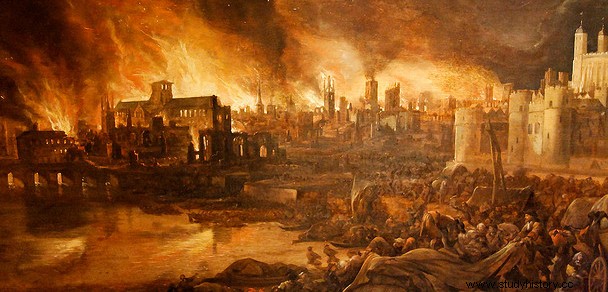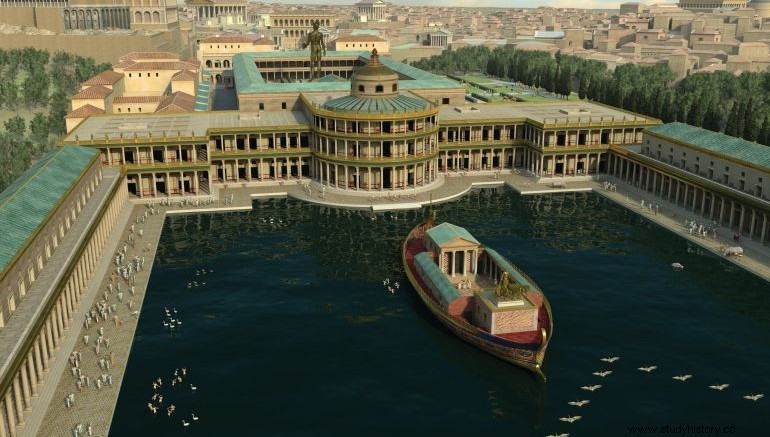It is curious that, in the first years of his reign, Nero he was recognized by the Roman Senate as Pater Patriae , Father of the Nation. It was a title not implicit in the position of emperor and that the Senate granted on merit. It was certainly a time of prosperity for Rome. Nero lowered taxes, secured borders, was a diligent manager of public affairs, and even had some brilliant successes in foreign policy. Everything presaged that the young emperor would lead Rome into a golden age. A fleeting illusion, which continued as long as the influence of his advisers, Seneca lasted. and Donkey . To quickly go over the matter, which is well known, I will say that the assassinations of his opponents and of anyone who tried to moderate the increasingly despotic and megalomaniac character of the emperor soon began to happen. The murders of his mother, Agrippina , and his mentor Donkey meant the final decline of Nero's personality. And with it, the ruin of Rome.

The great fire of Rome
Soon his extravagances and waste put in danger not only the public treasury, which was approaching bankruptcy, but even Pax Romana itself. , with the situation on the borders and foreign policy left to his fate. Those were the years of the uprising of Queen Boudica in Britain, of the Jewish revolt and the destruction of Jerusalem, of the Vindex rebellion in Gaul… This is how things were in Rome when, one night in July of the year 64, a fierce fire broke out in Rome, in the area of the Circus Maximus, where the shops that sold oils were located. For days the city burned uncontrollably and entire neighborhoods were devastated by fire.
And, when a firebreak was finally established and the flames stopped, a second fire started on a farm belonging to Tigelino , Nero's right-hand man and main adviser at the time.

The beginning of the persecution of Christians
For six days the city burned. Of the fourteen districts of Rome, four were completely razed to the ground and another seven seriously damaged. The imperial city would have to be rebuilt. The fact is that Nero's behavior immediately after the fire was impeccable. He opened the doors of his palace to the victims and fed them. All this, however, did not prevent suspicions of the author of the fire from being directed at him. Even today it is not clear if Nero was really the author although, as you will see below, it came in quite handy. The emperor for his part accused the Christians, a Jewish sect that was beginning to emerge in Rome. Many were arrested and executed, and this episode marked the beginning of their persecution. Whoever was to blame, at least a tenth of the city had been completely leveled, and Nero ordered the rubble to be removed quickly to prevent disease. It was time to think about reconstruction.
The Domus Aurea
And boy did he take care of it. On the tabula rasa left by the fire Nero planned to build a palace worthy of his megalomania and his love of art. And so began the construction of the most extravagant building in the history of Rome:the Domus Aure a (the Golden House). Fifty hectares of luxurious halls covered with frescoes, gold, ivory and precious stones, roofs with hatches through which slaves poured flowers and perfumes, a huge hall covered by a golden dome and which rotated continuously moved by the force of the water, gardens and arcaded patios, more than three hundred rooms in the private area alone and a large artificial lagoon, the Stagnum Neronis . Entering his new palace for the first time, Nero exclaimed:
I can finally live like a human being!

The Colossus of Nero and the Flavian Amphitheatre
And the Colossus . A bronze statue representing Nero with the attributes of Helios, more than thirty meters high, which the emperor ordered to be placed in the arcaded vestibule of the Domus Aurea . Years later, the emperor Hadrian relocated the statue to make room for the construction of the Temple of Venus and Rome, with which the Colossus of Nero ended up located in front of the Flavian Amphitheater, which had precisely been built on the previous location of the lagoon of the Domus. Golden. Over time, the amphitheater became popularly known as the Colosseum , due to the proximity of the colossus, and which is how it is currently known in Italian (Colosseo ), going into Spanish as Coliseo .

With the death of Nero in the year 68, the Domus Aurea was left unfinished. The Stagnum it was, as we have seen, closed to build on it the Flavian Amphitheater and the building was damaged by fire in the year 104. Emperor Trajan finally ordered to cover the great construction of rubble, putting an end to Nero's extravagance. Interestingly, this measure ensured the preservation of the lavish palace in the long run by preventing looting and exposure to the elements. Thus, the Domus Aurea it remained hidden underground while, on the surface, the Empire that had created it fell and the Dark Ages covered Europe.
The grotesque
And it was precisely with the advent of the Renaissance, in the 15th century, that chance returned Nero's House of Gold, long forgotten, to Roman life. It so happened that a young Roman accidentally fell through a crack in the Esquiline hill. and found access to the ruins of the Domus Aurea . The society of Renaissance Rome, ignorant of the history of the ruins, was amazed at these "caves" and their fascinating decoration. The frescoes, the gilded walls, the precious stones and, finally, all the grottesque decoration (the translation would be “grotesque”, related to caves) ended up awakening the inspiration of dozens of artists, who assimilated this style. A style that ended up spreading throughout Europe. Plant elements combined with vessels, cornucopias, human figures and mythological beings filling the entire space... Nero's taste ended up influencing and inspiring artists such as Raphael or Giovanni da Udine . And giving us a new word, since the ornate, extravagant, even sometimes vulgar or rude style that came out of those caves was henceforth known as grotesque .
Collaboration of Enrique Ros of History Notes
